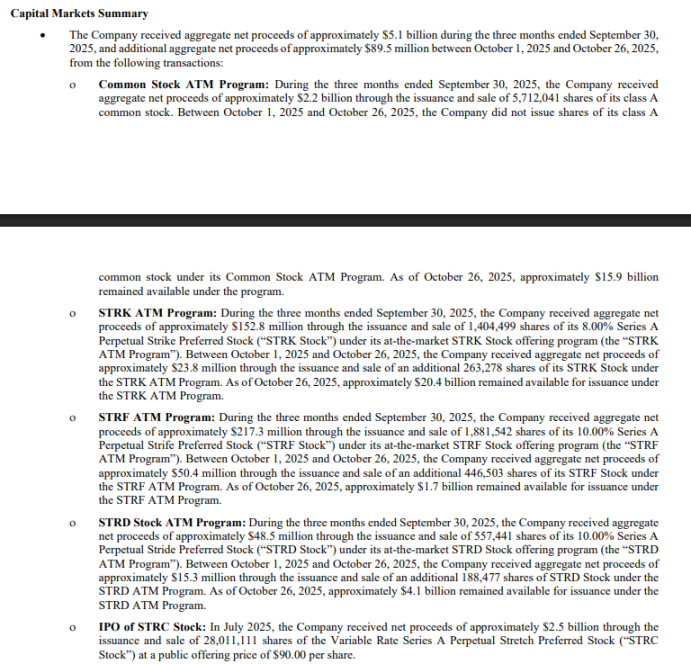Author: Phyrex Source: X, @Phyrex_Ni
Foreword: MSTR released its earnings report after the US stock market closed on Thursday. Earnings per share were $8.42, exceeding market expectations of $7.90. Third-quarter revenue was $128.7 million, exceeding market expectations of $118.3 million. MSTR's third-quarter earnings exceeded market expectations, and its after-hours price rose by more than 5%.
As of October 26, 2025, MSTR held a total of 640,808 $BTC, with a total cost of $47.44 billion, equivalent to a cost of $74,032 per Bitcoin. With the current BTC price at $107,300, this represents a paper profit of $21.333 billion. The net profit (paper profit) for the third quarter was $2.8 billion. What does this mean? American Express, ranked 67th globally by assets in the S&P 500, reported a profit of $2.9 billion in the third quarter of 2025. Another well-known tech company, Oracle, also reported a GAAP net profit of $2.9 billion in the third quarter. This doesn't mean MSTR is particularly impressive. MSTR received a B- junk stock rating in the latest S&P ratings, primarily due to the extreme volatility of Bitcoin's price. Therefore, I believe S&P's rating of MSTR is essentially the same as its rating of BTC, just slightly higher due to the lack of leverage. Thus, MSTR's net profit (on paper) basically meets the standards of a top 100 global company, largely due to the influence of BTC's price. Crisis? As of September 30, 2025, MSTR held $54.3 million in cash and cash equivalents. Does this mean it can only buy $54.3 million worth of Bitcoin? No, MSTR doesn't buy BTC with cash; it buys BTC through its capital structure. It converts fiat currency into BTC by issuing stocks, bonds, and structured credit.

However, the financial report for the third quarter of 2025 shows that as of October 26, 2025, MSTR's remaining issuance quota through multiple ATM programs totaled approximately $42.1 billion. In simpler terms, MSTR could buy up to $42.1 billion worth of Bitcoin.
So why did MSTR slow down its BTC purchases in the third quarter? MSTR divides its Common Stock ATM Program (with approximately $15.9 billion remaining) into three tiers, determining the issuance intensity and purpose based on mNAV levels: A. mNAV Threshold < 2.5x Tactically-Based Issuance: Paying Debt Interest, Funding Preferred Stock Dividends, and Other Corporate Favorable Circumstances (e.g., Small Cash Supplements). Limited Issuance Size to Avoid Excessive Dilutation at Low Premiums. B. mNAV Threshold 2.5x - 4.0x Opportunistically issued, primarily for purchasing Bitcoin. Balances funding with BTC yield, depending on market opportunities.
C. mNAV Threshold > 4.0x Actively issued, used extensively for purchasing Bitcoin. Accelerates during periods of high premium to maximize leverage.

Currently, mNAV is 1.27x (below 2.5x), so MSTR may only be used for debt/dividend payments rather than large-scale BTC purchases. This explains the slowdown in purchases in the third quarter (only $2.2 billion).
What is the formula for calculating mNAV?
MSTR's mNAV is a multiple of Enterprise Value (EV) divided by the net asset value of its Bitcoin holdings (Bitcoin NAV).
Enterprise Value (EV): Total company value, including market capitalization + debt + nominal value of preferred stock - cash. Bitcoin NAV: Market capitalization of the company's Bitcoin holdings (currently approximately 640,000 BTC, worth over $70 billion). Will MSTR collapse? Short-term (2026) probability: Low: Unless BTC crashes by more than 50%, the company has $42.1 billion in ATM credit available for rapid financing, and its operating cash flow is stable. Long-term (2028) probability: Moderate: If BTC remains sluggish for an extended period, the pressure of debt maturities will be significant (the first large tranche is in 2028). Statistics show that unless $BTC falls below $16,500, the risk of bankruptcy is highest. Actually, the price of BTC is not the main reason why MSTR might go bankrupt. If MSTR really does go bankrupt, the core reason should be that MSTR can no longer print shares to exchange for BTC. As long as the market still accepts MSTR's approach and provides MSTR with financing channels, then the probability of MSTR going bankrupt will be very low. When is MSTR the safest?
BTC is in a fluctuating upward cycle
The Fed's liquidity is improving or interest rate cuts are expected
The fiat capital market is willing to buy BTC exposure
US regulators are increasingly recognizing BTC
mNAV > 2.5, companies can continue to strengthen their balance sheets
Non-debt repayment period
From my personal point of view, firstly, there is no need to consider debt repayment before 2028, meaning that before 2028, the price of BTC is unlikely to cause a BTC crash. And in 2028…
From my personal point of view, firstly, there is no need to consider debt repayment before 2028, meaning that before 2028, the price of BTC is unlikely to cause a BTC crash. And in 2028…
 Weatherly
Weatherly






